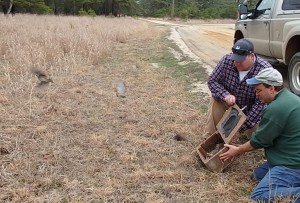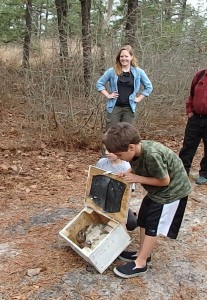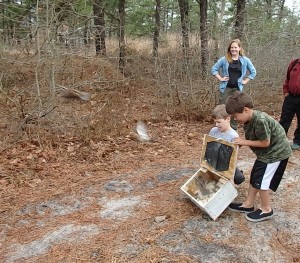This month, New Jersey Audubon once again arrived at Pine Island Cranberry for the second scheduled release of the translocated bobwhite quail program! Eighty-one quail, captured in Georgia by project collaborator Tall Timbers Research Station & Land Conservancy, were successfully translocated and released at the study site. According to NJ Audubon: “After receiving health screening testing and attaching leg ID bands and radio-signal transmitting collars to each bird, a total of eighty-one birds, (37 females and 44 males) were released in groups at the Pine Island Cranberry study site by NJ Audubon and initiative partners, Pine Island Cranberry, the New Jersey Division of Fish and Wildlife and the University of Delaware.”
“We are very excited about this second release of wild Northern Bobwhite. These new quail were released into areas where Northern Bobwhite were released last year, supplementing the newly developing population,” says John Parke of NJ Audubon. “Having those birds from last year at the site only increases the likelihood of survival of these new birds in the wild since the new birds will integrate with them and thus be influenced in their cover and foraging choices, nesting area selection and predator avoidance response in their new surroundings. We did not have that luxury last year.”
The birds from the first stage of the release are doing very well! From the NJ Audubon update:
“Through the use of radio telemetry, University of Delaware graduate students…monitored the birds and were able to confirm 15 nests, 127 eggs laid; and 66 chicks hatched in 2015. The birds were tracked throughout the winter by the students and were confirmed to have over-wintered successfully at the study site. It was noted that the quail were utilizing the young pine regeneration growth areas for cover throughout the entire winter season. These young pine areas were the result of vegetation regeneration in areas that had been harvested previously as part of forest stewardship activities performed by Pine Island Cranberry to improve overall watershed and forest health.”
The newly released birds will be tracked the same way.
“We’re pleased with how this project has progressed; the first year went very well. We enjoy working with NJ Audubon and the other partners, and are looking forward to another great year,” says CEO Bill Haines.
*Photos courtesy of John Parke.



